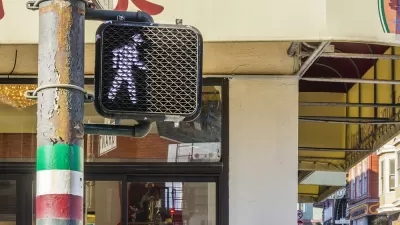Laws designed to keep pedestrians off streets are not merely useless, but create a variety of social harms.

Some months ago, I wrote that laws against so-called "jaywalking" (that is, crossing in places other than crosswalks or where traffic lights encourage pedestrians to cross) fail to promote safety, because traffic lights are inadequate guides to safety. When crossing midblock, a pedestrian need only watch out for traffic coming in one direction—right toward her. By contrast, when crossing at a light, a pedestrian may be in less danger from cars coming straight at him, but may be attacked by cars making left and right turns. Moreover, it is not at all clear that jaywalking is a major cause of pedestrian fatalities; although most crashes do occur outside intersections, these crashes often occur in places where there is no easily available crosswalk. According to traffic writer Tom Vanderbilt, "While jaywalking is often cited as a cause of pedestrian accidents, less than 20 percent of fatalities occurred where a pedestrian was crossing outside an easily available crosswalk." And even where a pedestrian is jaywalking, a crash may be caused primarily by driver misconduct.
However, my article did not fully address the social harms caused by these laws. I did mention that to the extent these laws discourage walking, they increase traffic danger, because more cars mean more potential crashes.
But even if this was not the case, the social benefits of jaywalking laws might be outweighed from their costs. In particular, jaywalking laws are harmful from a public health perspective, a social equity perspective, and a libertarian perspective.
The public health costs from increased driving have been amply discussed in smart growth literature. But just to summarize the key issue, when we drive instead of walk, we create two major types of public health risks. First, we harm ourselves. Less walking means less exercise, which means an elevated risk of many diseases; for example, the risk of type 2 diabetes is 31 percent lower for participants who engaged in regular moderate-intensity physical activity such as walking. Second, people who drive more and walk less endanger the rest of society. Even leaving aside the risks of climate change, particulate matter and other pollutants emitted from motor vehicles create significant costs. For example, one study found that particulate matter emitted from motor vehicles creates $211.6 million of health care costs in Auckland, New Zealand alone. So to the extent jaywalking laws reduce walking, they create increased risks of harm for both their intended beneficiaries and for society as a whole.
From a social equity perspective, jaywalking laws disproportionately harm the poor in two ways. First, poverty-level households are less likely to own cars than the average household, which means they walk more and thus are more likely to be ticketed. 20.4% of all poor people live in households with no access to a car, more than twice the national average. In urban areas, these percentages are higher: for example, in New Orleans, 46.7 percent of the poor live in such households, including the majority of the black poor.
Second, even if all Americans walked equally, jaywalking fines would harm poor pedestrians more than everyone else because these fines tend to be quite large (often in the $100-200 range) and are unrelated to ability to pay. This is especially true in cities where fines can lead to other legal consequences. For example, Ferguson, Missouri is notorious for its aggressive use of fines. If a Ferguson resident is fined and is more than a few minutes late* for a court date, she is arrested and charged additional fines totaling at least $170 ($120 for the main fine plus a $50 fee for an arrest warrant) and if she cannot afford to pay her fines she is imprisoned until the next court session. Because the relevant local court is in session three days per month, this unlucky resident may spend weeks in a local jail—for which privilege she is fined yet again!
Finally, such laws make no sense from a libertarian perspective. The ordinary (albeit oft-violated) norm of American public policy is that people should be at liberty when they are not harming others; for example, we allow smoking because smoking primarily harms only the smoker. Despite the fact that smoking creates indirect health consequences such as health care costs that affect society as a whole, society treats smoking more leniently than walking.
Where jaywalking laws are not enforced, these laws may not do much harm. But to the extent these laws are actually enforced, they create pollution and disease by reducing walking, and redistribute money from poor pedestrians to not-so-poor local governments.
*Technically, the resident must be absent from court for these additional fines to apply. However, courtroom doors close just five minutes after a court session starts, according to a recent Harvard Law Review article.

Alabama: Trump Terminates Settlements for Black Communities Harmed By Raw Sewage
Trump deemed the landmark civil rights agreement “illegal DEI and environmental justice policy.”

Study: Maui’s Plan to Convert Vacation Rentals to Long-Term Housing Could Cause Nearly $1 Billion Economic Loss
The plan would reduce visitor accommodation by 25% resulting in 1,900 jobs lost.

Planetizen Federal Action Tracker
A weekly monitor of how Trump’s orders and actions are impacting planners and planning in America.

Federal Homelessness Agency Places Entire Staff on Leave
The U.S. Interagency Council on Homelessness is the only federal agency dedicated to preventing and ending homelessness.

Restoring Northern India’s Himalayan ‘Water Temples’
Thousands of centuries-old buildings protect the region’s natural springs and serve as community wells and gathering places.

Milwaukee to Double Bike Share Stations
Bublr Bikes, one of the nation’s most successful, will add 500 new e-bikes to its system.
Urban Design for Planners 1: Software Tools
This six-course series explores essential urban design concepts using open source software and equips planners with the tools they need to participate fully in the urban design process.
Planning for Universal Design
Learn the tools for implementing Universal Design in planning regulations.
Caltrans
Smith Gee Studio
Institute for Housing and Urban Development Studies (IHS)
City of Grandview
Harvard GSD Executive Education
Toledo-Lucas County Plan Commissions
Salt Lake City
NYU Wagner Graduate School of Public Service






























